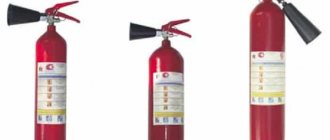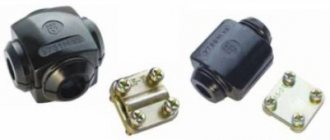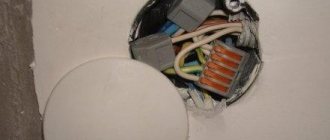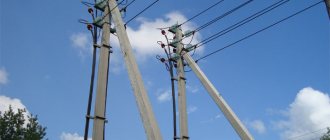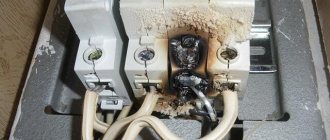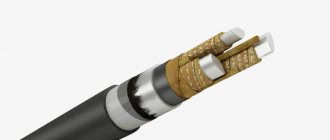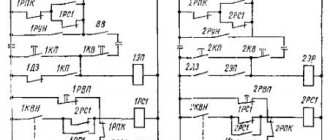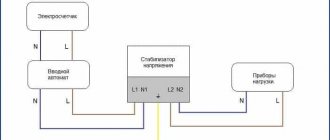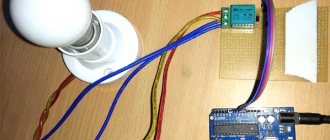Electricity is an integral part of every person’s life, which makes life easier and more comfortable. However, if certain rules for using electricity are not followed or working with faulty electrical appliances can lead to property damage or pose a threat to human life and health. For example, many people live in houses that were built several decades ago, and the electrical wiring of the premises remains from those times. Of course, the condition of such electrical wiring leaves much to be desired, and if the wires are not replaced in time, a fire may occur, which in the worst case may develop into a fire.
What happens if you pour water on a burning appliance?
Fire is a fast-spreading disaster that requires swift action when it occurs. But haste and stress often lead to rash and impulsive actions - a person grabs the first container of water he comes across (a vase of flowers, a bottle of drinking water, a mug of tea) and pours it onto the burning electrical wiring. Such an action will instantly lead to the most dire consequences.
From the physics course we know that water (in most cases) is a solution of various salts. These salts are in solution in the form of charged particles - ions. The presence of ions makes water (as well as tea, coffee, and various water-based liquids) an electrolyte - a substance that conducts electric current.
Water entering the combustion zone will cause the following consequences:
- In the short time that the jet connects the hands of the person engaged in extinguishing the fire and the wires exposed by the fire, the current can cause electrical injury that is dangerous to life and health. The risk increases if the container is made of conductive materials (for example, metal), your hands are wet, etc.
- Once inside the device, water will spread through the wires, causing more and more short circuits, which increases the risk of complete failure of the entire system. So, by pouring water on a fire-switched distribution cabinet, an inexperienced firefighter will destroy those devices that have not yet been damaged by the flame.
How to protect yourself from problems
“You can’t save on electrics,” explains Vadim Morozov. — At the same time, only a specialist can distinguish dangerous wiring from safe wiring “by eye”, and it is better to entrust this important work to him.
The main points you need to know before starting repairs:
- In a wooden house, it is better to use cables that match the type of room rather than wires.
- Open wiring is safer than hidden wiring
- The thickness of the section depends on the load. If you do not take this indicator into account, the cable will heat up and the insulation will melt, which will inevitably lead to a fire.
- It is better to choose products from well-known companies (whose markings should be applied along the entire length of the wire). Unlabeled and cheap wires may not be able to handle the increased power.”
Procedure for detecting the first signs of fire
If, when connecting one or more devices to the network, you hear the smell of burning plastic, you need to immediately take certain measures, because This is a clear sign of an electrical fire.
You need to proceed as follows:
- All repair work is carried out in a de-energized room, so first you need to unscrew the plugs.
- In a room where the smell of burning wiring was heard, it is necessary to disassemble all sockets and check the wires and contacts. Most often, the contact under the pressure washer weakens, which leads to overheating.
- If all sockets are in good condition, you should look into the junction box. It will not be difficult to notice the damaged area: the contact will be blackened, the cable insulation will have melted.
- In the case of faulty sockets, the wires are stripped and the contacts are restored. If a fire occurs in a junction box, then it is better to cut out the damaged area and insert another cable of the same cross-section in its place. The connection must not be made by twisting; the wires must be soldered, then the exposed areas must be insulated.
- If it turns out that the wiring has burned out over a significant length, you will have to completely replace the entire cable.
The fire safety of electrical wiring with aluminum conductors is lower than that of copper wiring. This is explained by the fact that aluminum tends to oxidize in air, which causes resistance at the junction of the wires to increase, which leads to overheating and fire. Therefore, it is better to completely replace such electrical wiring.
It is not necessary to lay new wires throughout the entire house at once; you can do it gradually, combining it with cosmetic repairs.
This process is quite painstaking and requires certain knowledge and skills. If you are not confident in your own abilities, it is better to seek the help of a professional electrician.
What to do when there is a fire?
If, despite all safety measures, an electrical device catches fire, under no circumstances should it be extinguished with water while the device is plugged in, because we may receive an electric shock.
You can extinguish with water only after de-energizing the device by unplugging the plug or turning off the fuses on the meter. A burning electrical appliance can be extinguished with a dry blanket or towel.
During a strong fire, if the fire cannot be extinguished and there is a lot of smoke, you should not open the windows - the flow of air supports the combustion and the flame will flare up even stronger. In this case, you should call the fire department as soon as possible. And be sure to leave the apartment, warning your neighbors about the fire.
If you have an old TV in your apartment or country house, then this video will be very useful for you:
If there are children in the room
In case of a fire, children behave differently than adults - most often they hide from the fire under the bed, in the closet, or climb into a corner. Even if you are sure that the house is safe, try to explain to the kids that in such cases they need to immediately run out of the room and under no circumstances return to it for forgotten things.
How to protect electrical wiring in an apartment from accidental fire? More details
The enemy is within
However, careless handling of fire is not the only cause of fires. According to statistics, 30% of fires occur due to an electrical short circuit, malfunction of electrical equipment and violations of its operation. In particular, the weak point of any home is old, worn-out and simply poor-quality wiring, in which a short circuit can occur at any time.
“Wiring is the heart of the house,” explains head of TDM ELECTRIC Vadim Morozov . — The safety of your home largely depends on its quality. Flickering light bulbs, the smell of melting wires, or electrical sockets may indicate that something is not right with the wiring. If these dangerous signals are ignored for a long time, a fire may occur at any moment.”
Article on the topic
From fire to flood. What is the shelf life of wiring and pipes in an apartment?
Precautionary measures
Consequences of combining aluminum and copper
Preventive measures to prevent wiring fires require time and money, but all this is not comparable with the consequences of a fire.
It is recommended to follow the following rules:
- Do not turn on several powerful consumers at the same time, as this creates a critical load on the line.
- Do not connect copper and aluminum wires directly. This is a dangerous option that will sooner or later cause an emergency.
- Install a residual current device in the apartment. With its help, the housing will be automatically de-energized even before the fire occurs.
- Inspect outlets, junction boxes and switches annually. Contacts should be cleaned and strengthened, and insulation should be renewed.
- Before leaving the apartment, turn off household appliances that are used periodically. When going on vacation, completely cut off the power to the room.
To be prepared for the worst case scenario, you should purchase a carbon dioxide or powder fire extinguisher and teach the whole family how to use it.
Source
Water and foam.
All types of devices, including foam ones, are used only on a de-energized system. This is how they extinguish fires that are visible and de-energized devices.
Powder.
A class E fire extinguisher is a powder extinguisher and is designed specifically for extinguishing electrical appliances and wiring. The essence of the powder action is that it knocks down the flame and covers the fire site with a layer, isolating it from oxygen. This type is very effective and has proven itself. It should be extinguished from a distance of at least a meter from the fire.
Carbon dioxide.
One of the most effective types of fire extinguishers. The principle of operation is that carbon dioxide sharply reduces the temperature and knocks down the flame. Also, after evaporation, it does not leave any traces; it can be used at a voltage of 10,000 VV. You can extinguish from a distance of at least a meter from the fire.
If there are no fire extinguishers nearby, it is permissible to use sand.
In the event of a fire with live wiring or electrical appliances, a number of requirements must be taken into account:
- It is required to make grounding for all special equipment: foam generators, special vehicles, hoses.
- A safe distance must be maintained.
- Foam devices are prohibited.
- You must be equipped with personal protective equipment.
Fire extinguisher selection criteria
If a fire hazard occurs in rooms with electrical equipment, it is recommended to use primary fire extinguishing means: fire extinguishers that are easily moved from place to place and used to extinguish fires with special substances that stop combustion. The basic rule when choosing a fire extinguisher is the correct monitoring of a number of factors: the distinctive properties of the equipment being protected, the category of the room, the volume of the protected area, the properties and mass of products susceptible to fire. You should also take into account the effectiveness of using a fire extinguisher to eliminate a fire of a particular class.
The use of extinguishing agents, depending on the fire class according to GOST 27331-87 .
How can you extinguish live wiring?
It happens that when an electrical wiring catches fire, there is no person nearby and it is impossible to quickly put out the flames. In these cases, in order to prevent a fire, it is necessary to act quickly and it is not always possible to run to the electrical panel to turn off the power to the house. A fire in its initial stages can be extinguished using earth and sand. But for such emergencies, it is better to have a special fire extinguisher in the house. Not all types of this device can be used to extinguish live appliances and electrical wiring. Therefore, before purchasing, you need to figure out which fire extinguisher can extinguish electrical wiring.
The best option is a carbon dioxide fire extinguisher, which can be used to extinguish fires in electrical installations under voltage up to 10,000 V. The extinguishing agent has a low temperature and is supplied under high pressure. Due to this, it is possible not only to eliminate the fire, but also to cool the smoldering sections of the electrical wiring. The main disadvantage of this device is that the vapors released during evaporation are harmful to human health. Therefore, it is prohibited to use a carbon dioxide fire extinguisher to extinguish fires in unventilated areas.
For apartments and private houses where the network voltage does not exceed 380 V, a good option would be to purchase a powder fire extinguisher, which can be used to extinguish electrical installations under voltage up to 1000 V. The powder agent quickly eliminates the fire by isolating the source of the flame from oxygen.
If it is possible to turn off the power, you can use water and foam fire extinguishers. Otherwise, you cannot extinguish electrical wiring with such means, because a person can be electrocuted. When extinguishing a fire, a distance of 1 meter must be maintained.
